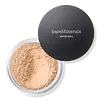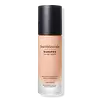What's inside
What's inside
 Key Ingredients
Key Ingredients

 Benefits
Benefits

 Concerns
Concerns

 Ingredients Side-by-side
Ingredients Side-by-side

Zinc Oxide 6.2%
Cosmetic ColorantWater
Skin ConditioningDimethicone
EmollientTrimethylsiloxysilicate
EmollientCaprylyl Methicone
Skin ConditioningButylene Glycol
HumectantIsohexadecane
EmollientCaprylyl Dimethicone Ethoxy Glucoside
EmulsifyingMethyl Trimethicone
Skin ConditioningIsododecane
EmollientSorbitan Isostearate
EmulsifyingDimethicone/Vinyl Dimethicone Crosspolymer
Skin ConditioningBis-Hydroxyethoxypropyl Dimethicone/Ipdi Copolymer Ethylcarbamate
Boron Nitride
AbsorbentPunica Granatum Pericarp Extract
Skin ConditioningGlycerin
HumectantPolysilicone-11
Phenoxyethanol
PreservativeSodium Chloride
MaskingCellulose
AbsorbentPolyphenylsilsesquioxane
Silica
AbrasiveTriethoxycaprylylsilane
Alcohol
AntimicrobialDi-C12-13 Alkyl Tartrate
EmollientDisteardimonium Hectorite
StabilisingPotassium Sorbate
PreservativeSodium Dehydroacetate
PreservativeCaprylic/Capric Triglyceride
MaskingTocopheryl Acetate
AntioxidantAlumina
AbrasiveLauryl Dimethicone
Skin ConditioningC20-24 Olefin
Skin ConditioningIron Oxides
CI 77891
Cosmetic ColorantZinc Oxide 6.2%, Water, Dimethicone, Trimethylsiloxysilicate, Caprylyl Methicone, Butylene Glycol, Isohexadecane, Caprylyl Dimethicone Ethoxy Glucoside, Methyl Trimethicone, Isododecane, Sorbitan Isostearate, Dimethicone/Vinyl Dimethicone Crosspolymer, Bis-Hydroxyethoxypropyl Dimethicone/Ipdi Copolymer Ethylcarbamate, Boron Nitride, Punica Granatum Pericarp Extract, Glycerin, Polysilicone-11, Phenoxyethanol, Sodium Chloride, Cellulose, Polyphenylsilsesquioxane, Silica, Triethoxycaprylylsilane, Alcohol, Di-C12-13 Alkyl Tartrate, Disteardimonium Hectorite, Potassium Sorbate, Sodium Dehydroacetate, Caprylic/Capric Triglyceride, Tocopheryl Acetate, Alumina, Lauryl Dimethicone, C20-24 Olefin, Iron Oxides, CI 77891
 Reviews
Reviews

Ingredients Explained
These ingredients are found in both products.
Ingredients higher up in an ingredient list are typically present in a larger amount.
Zinc Oxide is a mineral broad-spectrum UV filter; it is the broadest UVA and UVB reflector approved by the FDA. It also has skin protectant and skin soothing properties.
Zinc oxide is one of the most effective broad-spectrum UV filters. It protects against UVB, UVAII, and UVAI. In comparison to its counterpart titanium dioxide, zinc oxide provides uniform and extended UVA protection.
Another great benefit? This ingredient is highly photostable so it won't degrade easily under sunlight.
A common myth is that mineral UV filters are widely believed to primarily reflect UV light.
However, modern research shows titanium dioxide absorbs UV radiation like chemical filters (~95% absorption & 5% reflection).
Zinc oxide has great skin soothing properties so you'll likely find this in sunscreens formulated for sensitive skin or babies/children. It is unlikely to cause "eye sting" like other sunscreen ingredients.
Regulatory agencies consider zinc oxide to be non-toxic and safe. It has also been shown to not penetrate the skin.
Unfortunately, this ingredient does leave a visible white cast. This is why mineral sunscreens are often less cosmetically elegant than chemical or hybrid ones.
In cosmetics, zinc oxide can be found in both non-nano and nano-sized forms. The nano version is used to reduce white cast and improve the texture of sunscreen formulas.
There are ongoing concerns surrounding nano-zinc oxide's impact on marine ecosystems and whether it can be absorbed into skin.
Regarding marine ecosystems and coral reefs, there is no conclusive evidence that any form of zinc oxide (or any other sunscreen ingredients) will cause harm. The science is still developing but many consumers are keeping a close eye on this issue.
Please note, many destinations have reef-safety sunscreen rules. For instance, the U.S. Virgin Islands advises all visitors to use non-nano mineral sunscreens.
There has also been some stir about whether micronized or nano zinc oxide has potential photoxicity and absorption through the skin/lungs.
An in-vitro (done in a test tube or petri dish) study demonstrated micronized zinc oxide to have potential phototoxicity. There's no need to fret; the EU Commission's Scientific Committee on Consumer Safety has stated, "The relevance of these findings needs to be clarified by appropriate investigations in vivo." Or in other words, further studies done on living organisms are needed to prove this.
Current research shows zinc oxide nanoparticles do not penetrate intact or sunburned skin. They either remain on the surface or in the outermost layer of dead skin (stratum corneum).
Zinc oxide is one of only two classified mineral UV filters with titanium dioxide being the other one.
Fun fact: Zinc has been used throughout history as an ingredient in paint and medicine. An Indian text from 500BC is believed to list zinc oxide as a salve for open wound. The Ancient Greek physician Dioscorides has also mentioned the use of zinc as an ointment in 1AD.
Learn more about Zinc OxideThis ingredient is a combination of red, black, and yellow iron oxide pigments. This combination of colors is usually found in foundation, because it results in a "skin" color.